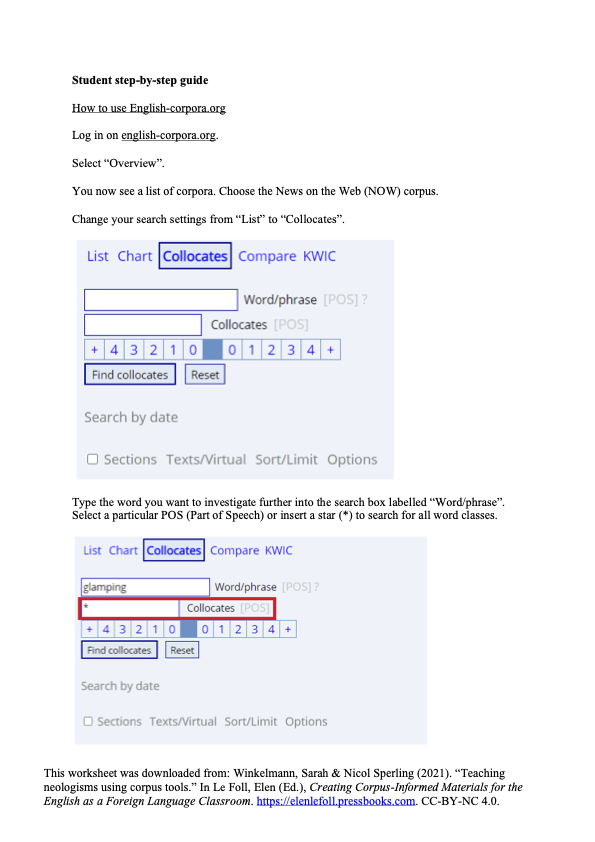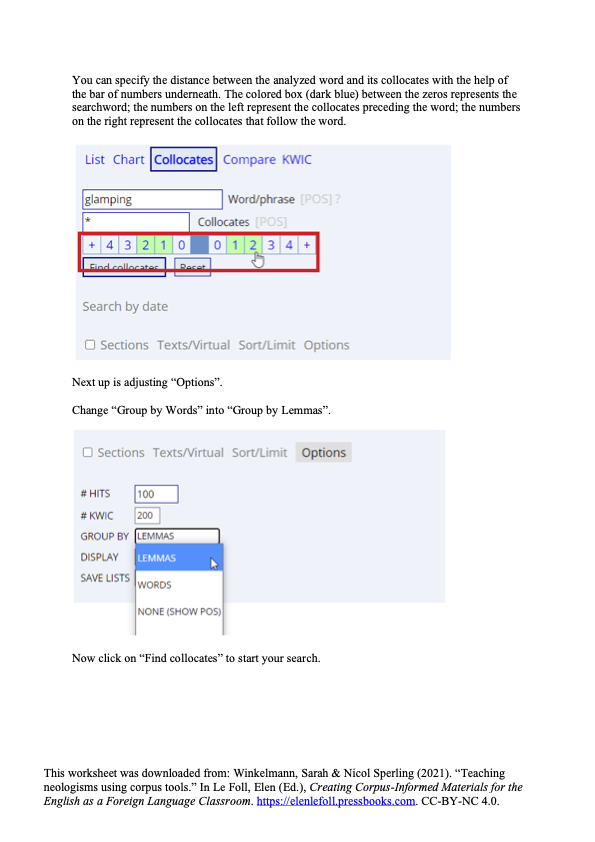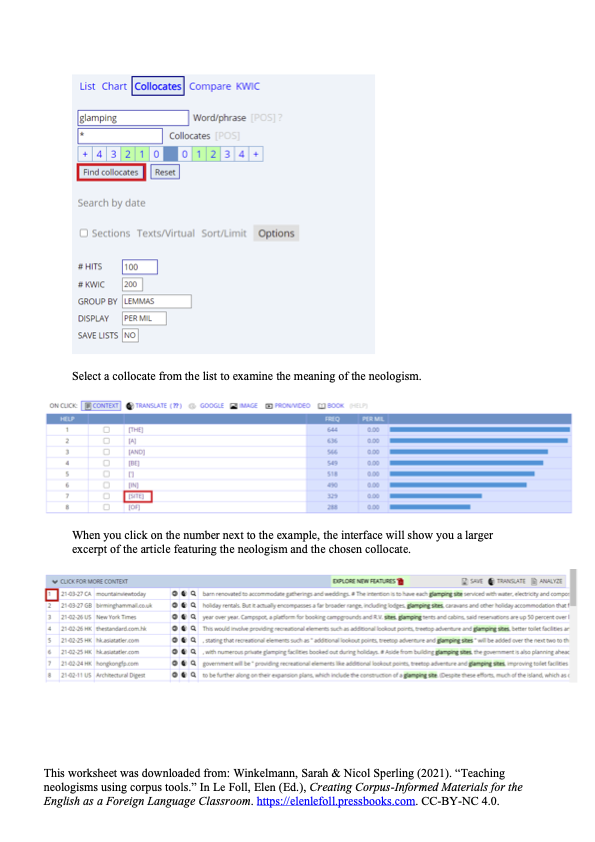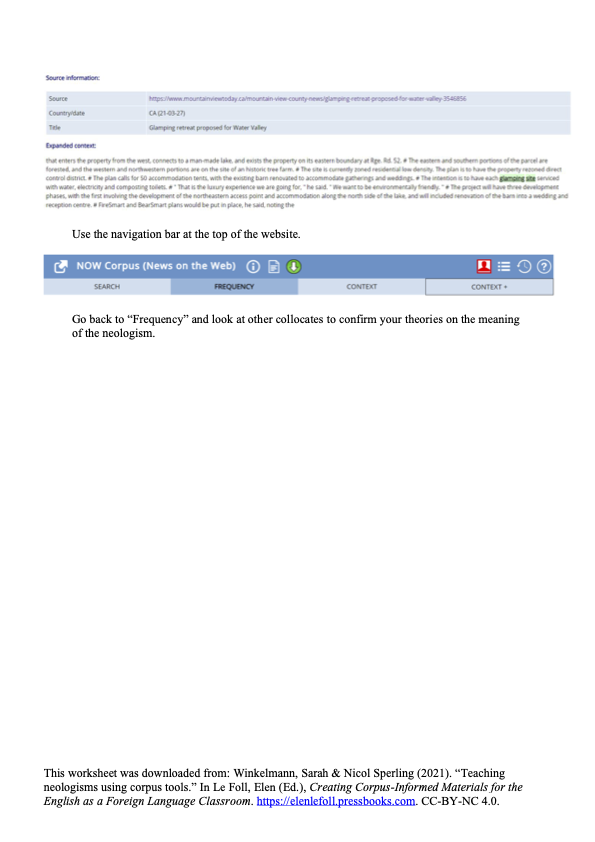Lesson ideas: Upper secondary school
7 Teaching neologisms using corpus tools
Nicol Sperling and Sarah Winkelmann
This chapter combines teaching stylistic devices, specifically neologisms, with corpus linguistics in the EFL classroom. It proposes a lesson plan in which methods and topic choice are strongly oriented towards Lower Saxony‘s Core Curriculum for Secondary Education, which emphasizes the importance of acquiring meaning through “intelligent guessing” and contextualization (Niedersächsisches Kultusministerium 2015: 16). It also states that students should be able to analyze and interpret literary and non-literary texts, e.g., by making use of their knowledge of stylistic devices (Niedersächsisches Kultusministerium 2017: 21). Stylistic devices are more frequently covered in the upper classes but can occasionally be discussed in lower grades, too. This lesson plan can serve as an introduction to teaching stylistic devices while at the same time helping students to develop “intelligent guessing” strategies, creative writing and reading comprehension skills.
In addition to raising your students’ awareness of neologisms and how language constantly evolves, this chapter encourages them to familiarize themselves and work autonomously with a corpus. It provides you with a lesson plan and a step-by-step guide to better understand and make use of the functions of a corpus in relation to the topic. It also includes suggestions on how to use additional resources, such as Wordspy.com, a website that provides you with novel words and phrases which have recently come into use in English.
2 Outline and objectives
This chapter prepares you for giving the proposed lesson by …
- showing you how to use the corpus tool english-corpora.org and Wordspy.com (~ 30 min).
- familiarizing you with the lesson plan (~ 10 min).
- providing you with suggestions on how to create corpus-based material for the proposed lesson (total of 1-2 hours; duration partly depends on how much the worksheet template needs adjustments to suit your learner group).
The proposed lesson is suitable for secondary school students aged 15 or older (10th grade according to the German school system)
- Lesson unit: Teaching stylistic devices
- Topic: Neologisms (90 minutes)
- Main competence: reading comprehension (contextualization and intelligent guessing)
Learning Objectives
After this lesson, students …
- can search for words and collocates using english-corpora.org.
- can systematically navigate through text sample results from a corpus.
- can work independently with a corpus and use it as a glossary and source of information.
- can deduce the meaning of unknown vocabulary (neologisms) used in different contexts, through intelligent guessing.
- can write their own definitions of previously unknown words on the basis of their corpus findings.
3 Corpus, corpus tools and methods
The proposed lesson makes use of the corpus website english-corpora.org as an analysis tool for students and teachers. It is freely accessible, which makes it particularly attractive for classroom use. Additionally, the handling of a corpus is easy to learn, as various tutorials can be found on the internet. Some of the main features of this corpus tool are the possibility to generate word lists, to display frequencies as charts and to find frequent collocations.
This chapter uses the NOW (News on the Web) corpus, which can only be found on english-corpora.org. Since neologisms are constantly changing and developing, especially in a digitalized age, a corpus which is regularly expanded by the addition of new content from articles and blog posts can be a useful classroom resource. Monthly content updates (about 180-200 billion words) put the NOW corpus, as of March 2021, at about 12.2 billion words. It is the largest and most up-to-date corpus found on english-corpora.org and also very comprehensive and differentiated, as it allows users to set particular search criteria such as year of publication and country. The NOW corpus also provides a regularly updated list of words and phrases provided by WordSpy.com, a constantly updated website of the most recent neologisms.
The proposed lesson enables students to contextualize neologisms by employing intelligent guessing strategies and using their existing knowledge with the help of the collocate function on english-corpora.org.
4 Teacher preparation
4.1 Step-by-step guide on using the corpus tool
The NOW corpus can be accessed by registering on english-corpora.org.

You can create a free account under “Register”, which can be found if you go to “My account”. This is also where you log in afterwards (Fig. 1).
If you click on “Corpora” after logging in, you will be provided with a shortcut to an overview of all the corpora listed on english-corpora.org. You can now choose the NOW corpus (Fig. 1).

Once you have clicked on the NOW corpus, the interface provides you with different features, as shown in Fig. 2. The left-hand side will be discussed later, when describing the tasks designed for the students. The right-hand side provides you with information on whether you are logged in on english-corpora.org. Further down, you will see a shortcut to “New words and phrases”. It will take you to a table of words and phrases which have recently been added to the English language and can therefore be used as a guide when choosing neologisms for your individual worksheet.

The table is divided into two different categories: “Culture/sociology/the World” and “Computers/technology/science” (Fig. 3). It contains the word and a brief definition. By clicking on the word, you obtain information on its frequency of use by year and country.
Since this list is provided by WordSpy.com, you will also find a link to this website. Here is a brief overview of what it looks like and instructions on how to find words and phrases.

WordSpy.com lists over 3,000 words and phrases including a brief definition, related words, etymology and examples of its usage. The website itself is well structured. The menu on the left side (Fig. 4) offers different ways to search for words, e.g., the option “By Date”, which arranges words and phrases by year and month. Another way to find new words is the option “Random Word”, which will show you a new neologism or phrase each time you click on it. It is also possible to conduct a more detailed search by selecting “Full Search” or to search in different categories (“By Tag”).


Once you have chosen a word you can simply click on it and Wordspy.com will present you with a more detailed overview of morphologically related words, an account of the word’s etymology (Fig. 5), and various examples of how it is used (Fig. 6).
When selecting a word, it is crucial to check whether it occurs with sufficient frequency in the corpus for students to work with.

When you go back to english-corpora.org, once again choose the NOW corpus and click on “Collocates” (Fig. 7). First, type in the neologism you want to analyze, in this case glamping, and select the parts of speech you are interested in. This can be done by clicking on “Collocates [POS]”. If you only want to find examples of the word being used as a noun, choose the corresponding category from the dropdown menu (Fig. 7). To search for all word classes, type in a star (*). Second, select the “span”, i.e., the distance between the search word and its collocates; if you want to know which words typically occur immediately before or after the word, for instance, select position “1” on both sides (Fig. 7). Third, change the search settings to “Group by Lemmas” and “Display Per Mil”. You can now click on “Find collocates” to get results.

As a result, the corpus displays a list of collocates sorted by frequency (Fig. 8). Note that there is no distinction between the preceding and the following word. To find out whether a collocate typically occurs to the left or right of the search term, click on the word in question. This will provide you with more context.

Here, we chose the collocate experience. The website provides you with a list of example sentences from news websites, along with additional information on the source, country, and date (Fig. 9). To see more context, click on the corresponding number on the left-hand side, which redirects you to a larger excerpt of that article, including the full source and title (Fig. 10).

You can always choose to switch between “Search”, “Frequency”, “Context”, and “More context” on the navigation bar above.
4.2 Customizing the worksheet template
Below you will find a worksheet template and an answer sheet, created specifically for the proposed English lesson. This material was created in February 2021 and is targeted at German 10th grade students of the Gymnasium (a type of secondary school in Germany). The worksheet provides the students with three main tasks outlined in the lesson plan. At this point, it is important to consider the language proficiency of your learner group. The meanings of the neologisms on the worksheet might be too obvious or they might be outdated. Considering ongoing language change, especially the introduction and spread of new words, it is crucial to scrutinize the neologisms on the worksheet. Finding more suitable words should not be too difficult thanks to the very many neologisms listed on Wordspy.com and our guide on how to use the website.

 5 Lesson plan
5 Lesson plan
5.1 Outline
The plan is designed as a 90-minute lesson for 10th grade students in secondary school. It can be implemented within or at the beginning of a teaching unit on analyzing literary works/stylistic devices. The preceding lesson may be used to introduce corpus tools and methods in order to save time during the planned lesson. You may also want to give an introductory lesson on the use and function of the most common stylistic devices prior to the proposed lesson.
We advise you to begin the lesson without telling the students what the topic will be. The teacher starts by showing them a chat from 2021 filled with neologisms, all linked to the Covid-19 pandemic (Fig. 11).

After two students have read the chat out loud, the teacher asks the class what the conversation is about and what is striking about the choice of words. Students may or may not be familiar with neologisms. It is the teacher’s task to use the neologisms of the chat to initiate a class discussion and to activate the students’ prior knowledge, encouraging them to work out the definition and function of this stylistic device. The pandemic can be used as a concrete example of how language evolves and changes over time. As a result of new situations and events, novel words and phrases are created and become part of language use. However, these newly created words do not always remain neologisms. Over time, they either vanish or are added to the dictionary, as you can see by our example of glamping.
The main part of the lesson focuses on working with the NOW corpus on english-corpora.org. Students are provided with a worksheet which features a list of neologisms (see 4.2). The first task is to get together with a partner and to speculate about possible meanings of the listed words. Some of these suggestions can be collected on the blackboard in order to review them at the end of the lesson. One aim is to enable students to figure out the meaning of a word through contextualization and intelligent guessing or by analyzing its context. To further explain why such strategies are useful, you can point out that most neologisms will not be found in a dictionary. Up-to-date corpora, however, might include words which have not yet been taken up by dictionaries. Subsequently, the NOW corpus and the corpus website are introduced to the students. Here, it is important to consider whether your students have already worked with english-corpora.org or not. If not, make sure to give them a brief explanation and guide them through the different functions. With the help of a step-by-step guide for using the corpus tool (see Appendix), students work in pairs and complete the tasks on the worksheet. They search for the given neologisms in the NOW corpus, find texts which include these neologisms as well as their most frequent collocates, and discover their meaning by analyzing the context. In addition, they note down an example sentence for each neologism and formulate their own definitions of the previously unknown words.
The findings are discussed and recorded by, firstly, comparing the results in groups of four; secondly, by presenting them in class; and thirdly, by contrasting them with the assumptions made by the students at the beginning of the lesson. After the lesson ends, the final results should be made available to all of the students, which is why you should note them down during the class discussion.
Additional tasks and ways to adjust the lesson according to individual needs and preferences are presented in section 6.
5.2 Lesson plan
|
Procedure |
Content |
Arrangement |
Media/Material |
|
Introduction ~ 10 min |
WhatsApp Chat from 2021
|
Plenum |
Projector, laptop
Answer sheet “Corona neologisms and their meaning”
Blackboard |
|
Main part
~ 10 min
~ 15 min
~ 35 min |
Guessing the meaning of neologisms (task 1)
Introducing the corpus tool
Working with the corpus tool
|
Partner work Plenum
Plenum
Plenum
Partner work |
Worksheet Blackboard
Laptop/tablet, projector
Worksheet, step-by-step guide for students, laptops/computers |
|
Conclusion ~ 20 min |
Comparing results
|
Groups of 4
Plenum, message chain |
Worksheet
Document imaging camera/laptop, projector, worksheet |
Table 1: Lesson plan; T= Teacher
6 Options and further ideas
Different proficiency levels require different activities and methods. You might want or need to adapt specific parts or activities of the lesson according to your individual learner group. This section proposes possible alternatives and additions as well as impulses for modifying the lesson to get the most out of it for your students and to suit your teaching style.
As it was already mentioned, it should be taken into consideration that an introduction to english-corpora.org and corpora in general prior to the lesson could make it easier for some students to follow the corpus activities, while also saving time during the main part of the lesson. However, we assumed that there is usually not enough time to integrate an introductory lesson into your teaching unit. Therefore, we included an introduction to the NOW corpus and an explanation of the corpus tools in the lesson plan. Nonetheless, we still advise you to reserve an earlier lesson to familiarize students with the basics.
Moreover, specific parts of the lesson plan could be replaced with alternatives. For instance, another option for the warm-up activity could be to provide the students with a list of neologisms and make them guess their meanings right away. This could also be done in the form of a challenge or game, e.g., by creating teams and collecting guesses on the blackboard. The students would then be required to use the corpus tools to investigate which guesses were right and which ones were wrong. Another option would be to initiate a class discussion about what neologisms are and to collect examples of recent English neologisms which the students might have heard of. This approach activates the students’ existing knowledge on stylistic devices.
Additional tasks can be prepared for very advanced students. The corpus tool provides far more features which can be examined by the students. The chart function, for instance, allows you to see in which years a neologism appeared most frequently and also lets you search for the frequency of a word in different countries. This could be useful for finding out when a neologism came into being and how it is used in different varieties of English. The meaning or frequency of use of an English neologism may well differ between news texts from India and the United States. For instance, in India the neologism butterfingers occurs 0.08 times per million words, whereas in the United States it is found 0.03 times per million words (NOW Corpus). Students could investigate why this might be the case. When analyzing the Indian text samples, it becomes evident that the word is often used in reference to the comic book character “Butterfingers”, created by Khyrunnisa A., who is a famous Indian author of children’s fiction. By contrast, a closer look at the texts published in the United States reveals that “Butterfingers” is also the name of a famous candy bar. However, both countries also use the word to describe a “person who drops things they are carrying or trying to catch” (dictionary.cambridge.org). The chart function, which displays a word’s frequency sorted by years, can be used to analyze in what year a neologism first appeared and when it was most frequently used. For instance, the chart of the NOW corpus shows that the use of the word Brexit started to increase in 2016, when the results of the Brexit referendum were published and discussed all over the media (see Fig. 12).
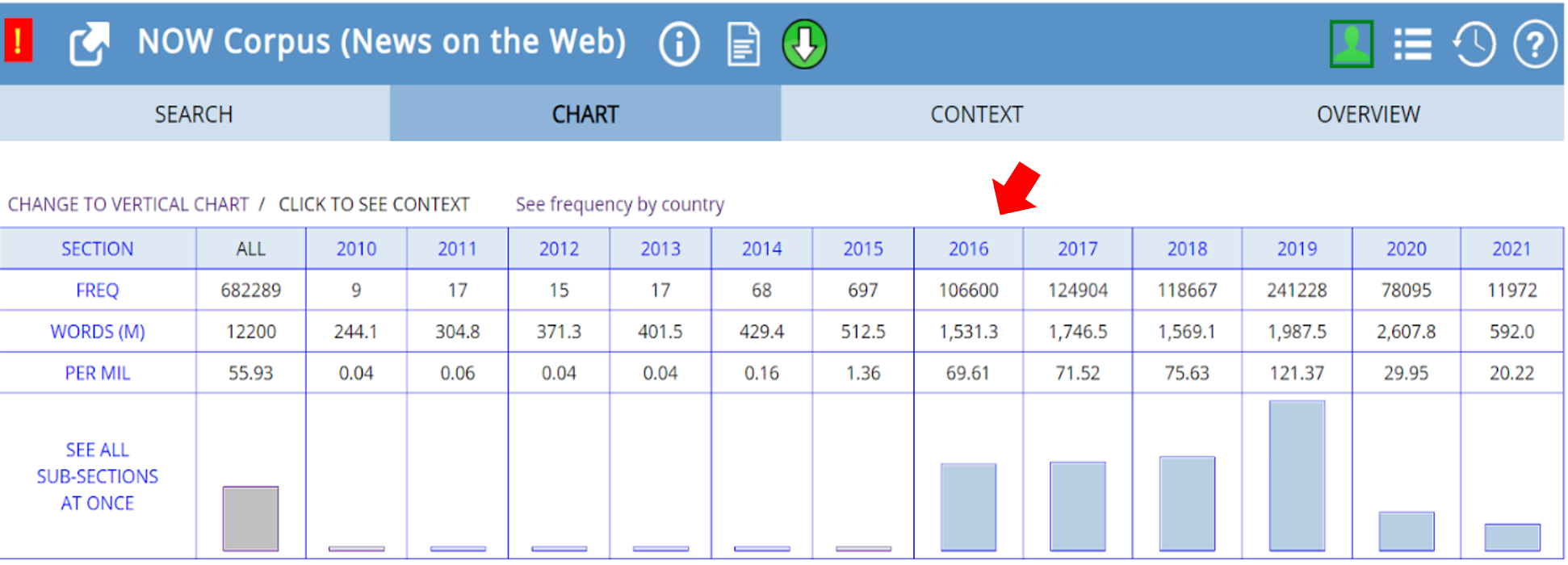
These examples show the variations in meaning and usage of a word, as well as its connection to past historical and cultural events, which can be included into your lesson. Students could either work autonomously and follow their personal interests once they have finished the tasks on the worksheet, or you could choose which words/topics might be relevant to investigate further.
Lastly, we believe that the corpus tools are not only beneficial to examine neologisms. Other stylistic devices such as juxtapositions and metaphors could also be analyzed by using english-corpora.org. Hence, students could search for phrases like heaven and hell (juxtaposition), eyes like and cold as (both metaphors) and compare different types of texts (e.g., newspaper articles and fictional texts) to analyze the functions and effects of stylistic devices. Apart from letting your students work with english-corpora.org, you could also make use of the website’s corpus tools to create more of your own corpus-based material. English-corpora.org contains several different corpora with various functions, such as the possibility to search in specific text genres, e.g., only fictional texts, in the Corpus of Contemporary American English (COCA). Thus, applying corpus methods to teach, learn and engage further with stylistic devices has great potential. Our ideas and proposed lesson plan are specifically designed to allow adjustments in order to fit your teaching unit and your individual learner group.
7 Caveats & limitations
Implementing ideas and creating new materials for EFL teaching may come with certain difficulties or obstacles. Our intention is to consider possible difficulties the designed lesson may cause as well as to mention the limitations of this chapter.
- Avoid swear words and inappropriate expressions that might come up in the search results.
- Make sure that all neologisms on the worksheet can actually be found in the corpus and that there are enough occurrences to find out the meaning of the specific neologism. Keep different proficiency levels of your students in mind (some students might need more support when working with the corpus-tool, especially if it is their first time working with it).
- It may be necessary to provide explanations of possibly unfamiliar functional terms such as “collocates” or “lemmas”.
Lastly, the corpus tool itself holds one small limitation regarding the number of searches you want to perform. After a few searches, english-corpora.org will ask you to upgrade to a premium account (Fig. 13). You do not need to update: you can simply wait and then click on “Click here to continue with your search” when it appears (Fig. 13).


8 Conclusion
The method of using corpus tools in the EFL classroom might be quite new to teachers but it can provide promising opportunities that promote progressive and innovative teaching while at the same time being compatible with the curriculum. After this lesson, students and teachers should be familiar with basic features and functions of the NOW corpus and english-corpora.org in general, which is a great foundation for employing corpus-informed language teaching materials in further lessons. Corpus work can constitute a valuable benefit because it improves explicit learning and encourages students to work autonomously. The choice of topic and methods has great potential to activate and motivate students, as unfamiliar, possibly funny-sounding words may spark students’ interest in learning more about them, thus keeping them focused on the lesson. Furthermore, students become familiar with more techniques to facilitate intelligent guessing and figuring out what a word means and in which contexts it can be used without using a dictionary. Finally, all the ideas and thought-provoking impulses may encourage more teachers to employ new and more diversified teaching materials in their classes, as it can lead to enriching and motivating lessons in the EFL classroom.
9 Resources and references
Cambridge Advanced Learner’s Dictionary. 2021. Butterfingers”. https://dictionary.cambridge.org/us/dictionary/english/butterfingers (29 March ,2021).
Corpus of Contemporary American English (COCA). https://www.english-corpora.org/coca/.
Electoral Commission. 2016. Referendum on the UK’s Membership of the European Union. http://web.archive.org/web/20160630154529/http://www.electoralcommission.org.uk/find-information-by-subject/elections-and-referendums/upcoming-elections-and-referendums/eu-referendum (29 March, 2021).
English-corpora.org. www.english-corpora.org/.
Ewing Bölke, Susannah. 2020. Brand New Neologisms. English Explorations. https://englishexplorations.check.uni-hamburg.de/brand-new-neologisms/ (16 May, 2021).
Locke, Gary. 2020. Neologisms, 2020 Edition. English Language Blog. https://blogs.transparent.com/english/neologisms-2020-edition/ (16 May, 2021).
News on the Web Corpus (NOW). https://www.english-corpora.org/now/.
Niedersächsisches Kultusministerium. 2015. Kerncurriculum für das Gymnasium, Schuljahrgänge 5-10: Englisch. https://cuvo.nibis.de/cuvo.php?k0_0=Dokumentenart&v0_0=Kerncurriculum&k0_1=Schulbereich&v0_1=Sek+I&k0_2=Schulform&v0_2=alle&k0_3=Fach&v0_3=Englisch&docid=1197&p=detail_view (28 June, 2021).
Niedersächsisches Kultusministerium. 2017. Kerncurriculum für das Gymnasium, gymnasiale Oberstufe: Englisch. https://cuvo.nibis.de/cuvo.php?k0_0=Schulbereich&v0_0=Sek+II&k0_1=Fach&v0_1=Englisch&docid=1132&p=detail_view (28 June, 2021).
Word Spy. www.wordspy.com/.
10 Appendix
Answer sheet: Corona neologisms and their meanings
|
Neologism |
Meaning |
|
Zoomer |
Someone from Generation Z (the expression alludes to the term ‘boomer’, i.e., a member of the baby boomer generation). |
|
Coronahobbies |
A hobby discovered or more regularly practised due to Covid. |
|
Doomscrolling |
Reading through all the bad Corona related news on a technical device. |
|
Zoombie |
Feeling like a zombie becoming after giving/attending classes on Zoom all week. |
|
Coronacleaning |
Cleaning as a hobby during the corona pandemic. |
|
Procrastibaking |
Baking as a hobby during the corona pandemic. |
|
Hairpocalypse |
A terrible haircut after a long time of not having been to the hairdresser. |
|
Quarancut |
A haircut given at home (during quarantine). |
|
Covidiots |
People who ignore the shutdown and hygiene measures of Covid. |
|
Mask-shaming |
Denouncing someone for not wearing or wearing a mask. |
|
Quaranteen |
A teenager who spends parts of their youth in shutdown/quarantine. |
|
Blursday |
A day on which one does not notice time passing by. |
